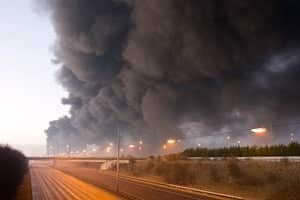Editor's note: This is our introduction to API 2350, which covers best practices for preventing tank overfills in petroleum facilities. You can find the second post on mandatory management and operations practices for preventing tank overfills. The third entry, on tank operation and alarm automation categories, can be found here. Our final post on API 2350 covers Levels Of Concern within a petroleum storage tank and the necessary alarms at each one.
 On December 11th, 2005 at about 6 a.m. in the morning a massive explosion, originating from an oil storage terminal, rocked the town of Hemel Hempstead, a municipality located outside of London, UK. All of the windows in nearby buildings were blown out, and there were later reports claiming that the blast could be heard in France, Belgium, and the Netherlands.
On December 11th, 2005 at about 6 a.m. in the morning a massive explosion, originating from an oil storage terminal, rocked the town of Hemel Hempstead, a municipality located outside of London, UK. All of the windows in nearby buildings were blown out, and there were later reports claiming that the blast could be heard in France, Belgium, and the Netherlands.
The event measured a 2.4 on the Richter scale and news agencies described the incident as the biggest in peacetime Europe. Luckily, there were no deaths since the office buildings in the vicinity were mostly empty. However, 43 people were injured and 2 were seriously injured.
The explosion took place at one of the tanks at the Hertfordshire Oil Storage Terminal. This initial blast subsequently led to smaller explosions and ultimately resulted in a major conflagration. It took over two days for crews to put out the fire. In all, 20 storage tanks were destroyed.
Soon after the incident, a government inquiry was conducted. The investigation reported that the explosion was caused by an overfilling of tank 912 at the Buncefield depot. This overfilling led to a rapid formation of a vapor cloud that was eventually ignited by an unknown ignition source. Investigators concluded that it was faults in the management system related to tank filling that was to blame. Terminal operators had little control over flow rates and timing of receipts. Meaning they did not have sufficient information available to them to manage the incoming fuel properly. The companies responsible for the depot were fined millions of Pounds.
Events like the Buncefield Incident and others gave rise to the petroleum industry revisiting its standards on tank overfill protection. A direct result is the publishing of API 2350 Edition 4.
Created by the American Petroleum Institute, API 2350 outlines the minimum requirements needed to comply with the latest best practices to prevent tank overfills in petroleum facilities.
While we plan to discuss specific components found in the standard in future articles, we thought we would take just a moment to point out a major difference between the new and older editions.
Instead of the standard just making strict specifications that companies are required to adhere to, like UL, or CSA certifications, edition 4 takes an approach that is comparable to continuous improvement operation standards like six sigma. The standard advocates that companies weave an overfill prevention process into the underlying fabric of the corporation.
“In order to be effective, these systems must be integrated into the “corporate culture” and must be fit for purpose. Even the simplest of such systems require lots of time, energy and resources and must be actively supported by the very top level of the organization. Without top management active support and promotion, there is no hope for a working management system.”
Phil E. Meyers, API 2350 Committee Chairman
Look forward to future articles where we will go into further detail as to what components make up the standard. Please contact us if you have questions about the standard between now and then.
Image by Winstainforth via Wikimedia Commons